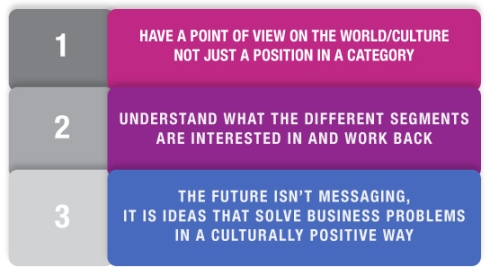
Even two years ago many people wouldn’t have predicted that the primary selling point of a mobile handset in its own advertising would not be the hardware, the screen size, calltime or even brand message, but the fact that you can get Facebook (and other feeds) on it.
The current rapid growth of mobile social networks is a symptom of finally moving beyond the endless powerpoint based hype of “social media marketing” to a new realism. Mobile that takes social networking firmly away from sitting behind computers and means we can bring back the lost real social elements of face to face encounters and real world experiences.
Mobile coming together with social networks means that we can physically see these networks actual transformative value. It is one of the many things leading to what I hope is a sense of “won’t believe the hype” maturity in our industry (and wider society).
This “always on”, real-time world of Social periphery or ambient intimacy [explored in the diagram above] has been on the cards since the birth of Jyri Engeström’s Jaiku but it has taken easy and seamless mobile integration to really snowball into the mainstream.
Now the challenge is what do we do with it?
Recently I’ve been exploring the idea of brands needing to function as both enabler and filter for people in order to have a role beyond passive loyalty. They not only need a position within a market or category but must also have a clear and simple point of view on the world/culture in which they operate.

This evolving way we deliver and communicate is at the heart of the opportunity for mobile networks and technology providers in light of their move to become the enable and the filter for people’s social peripherial vision and networks.
But what will the work need to look like?
Technology lets the crowd raise-up the things it likes with links and tags and re-posts, and damn the things it doesn’t like with a pointed lack of attention. Old passive message, big idea, objective correlative creative with a big call to action, and series of key frame proof points doesn’t cut it anymore. There is too much noise: now things have to be good enough to share.
But just because something is good enough to share or inherently interesting doesn’t mean it will catch on and spread through networks. The work itself must be implicitly structured for the network (as illustrated by SharedEgg) and stimulate the growth or reshaping of the network, not just have an AddThis or send to a friend button.
- It must contain an idea that can be reprocessed and played with, passed on and owned.
- It needs to be an idea that people can use but not be completely dry and functional.
- It needs to provides more than the (important) phatic entertainment and brand story BUT ALSO vital real world reward and social currency.
- It must allow the crowd to create nodal points* within their part of the network.
Mobile is the tangible, first thing you see in the morning, last thing you check at night, always with you object, that will enable people to pull their networks and these smaller, higher frequency, locally relevant ideas together so that they can create their own digital nodal points or experience their friends’ ones while on the move.
This is why the work we do needs to be good enough to share with everyone, anywhere.
———————————————–
* If we can think of a Nodal Point as a (potentially distributed) collection of content, conversations and links that spread a meme/concept and cause the ideas, experiences and other journeys around it to be reshaped and “dragged” (just like a planet’s mass influences the passage of time around it), then it is a key point in an interactive experience or someone’s digitally enabled life.
Tags: ambient intimacy, cellphones, diagram, infographic, mobile, social networks, social periphery







 What can we do with the data that a connected object generates? It offers a potential for greater immersion in sports – where people love statistics – where the whole game and every movement can be modeled and reported. This has already been implemented to leverage
What can we do with the data that a connected object generates? It offers a potential for greater immersion in sports – where people love statistics – where the whole game and every movement can be modeled and reported. This has already been implemented to leverage 



